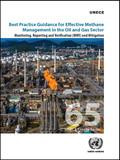
The document provides guidance for developing and implementing effective practices for monitoring, reporting and verifying (MRV) methane emissions from the oil and gas sector. It also provides guidance on remediation practices. The document is meant to serve as a resource for a broad audience, including owners and operators of oil and gas facilities and policymakers at all levels of government. Its discussion of MRV and mitigation opportunities is intentionally “principles-based”, recognizing that conditions vary greatly across oil and gas facilities and that legal, political and institutional aspects differ by jurisdiction.
The oil and gas industries are important sources of anthropogenic methane emissions and, though methane has a relatively short residence time in the atmosphere, its volumes are replenished continuously. Methane, the primary component of natural gas, can be released to the atmosphere during oil and gas production, processing, storage, transmission, distribution, and use. Because methane has a much higher warming potential than CO2, effective management is important for countries’ climate change mitigation strategies and is one of the few approaches that represents a significant, cost-effective, and near-term opportunity.
Oil and gas will play a key role in the future sustainable energy system even under a scenario that meets stringent climate objectives – the sector will continue to support economic growth and social progress as alternatives to oil and gas will take time to emerge and achieve global scale. Addressing the methane challenge will improve the sector’s sustainability credentials.
For more information please visit website dedicated to the publication and a homepage of the project within the framework of which the Best Practice document was developed.
Please download the English version of the Best Practice Guidance document below. Kindly note that it is available also in the following languages: